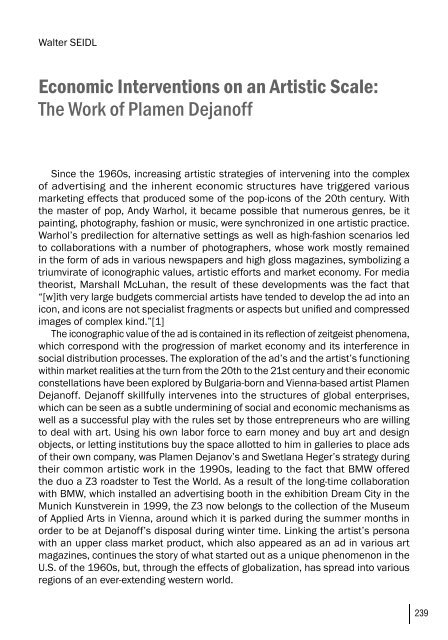art-e-conomy _ reader - marko stamenkovic
art-e-conomy _ reader - marko stamenkovic
art-e-conomy _ reader - marko stamenkovic
You also want an ePaper? Increase the reach of your titles
YUMPU automatically turns print PDFs into web optimized ePapers that Google loves.
Walter SEIDL<br />
Economic Interventions on an Artistic Scale:<br />
The Work of Plamen Dejanoff<br />
Since the 1960s, increasing <strong>art</strong>istic strategies of intervening into the complex<br />
of advertising and the inherent economic structures have triggered various<br />
marketing effects that produced some of the pop-icons of the 20th century. With<br />
the master of pop, Andy Warhol, it became possible that numerous genres, be it<br />
painting, photography, fashion or music, were synchronized in one <strong>art</strong>istic practice.<br />
Warhol’s predilection for alternative settings as well as high-fashion scenarios led<br />
to collaborations with a number of photographers, whose work mostly remained<br />
in the form of ads in various newspapers and high gloss magazines, symbolizing a<br />
triumvirate of iconographic values, <strong>art</strong>istic efforts and market e<strong>conomy</strong>. For media<br />
theorist, Marshall McLuhan, the result of these developments was the fact that<br />
“[w]ith very large budgets commercial <strong>art</strong>ists have tended to develop the ad into an<br />
icon, and icons are not specialist fragments or aspects but unified and compressed<br />
images of complex kind.”[1]<br />
The iconographic value of the ad is contained in its reflection of zeitgeist phenomena,<br />
which correspond with the progression of market e<strong>conomy</strong> and its interference in<br />
social distribution processes. The exploration of the ad’s and the <strong>art</strong>ist’s functioning<br />
within market realities at the turn from the 20th to the 21st century and their economic<br />
constellations have been explored by Bulgaria-born and Vienna-based <strong>art</strong>ist Plamen<br />
Dejanoff. Dejanoff skillfully intervenes into the structures of global enterprises,<br />
which can be seen as a subtle undermining of social and economic mechanisms as<br />
well as a successful play with the rules set by those entrepreneurs who are willing<br />
to deal with <strong>art</strong>. Using his own labor force to earn money and buy <strong>art</strong> and design<br />
objects, or letting institutions buy the space allotted to him in galleries to place ads<br />
of their own company, was Plamen Dejanov’s and Swetlana Heger’s strategy during<br />
their common <strong>art</strong>istic work in the 1990s, leading to the fact that BMW offered<br />
the duo a Z3 roadster to Test the World. As a result of the long-time collaboration<br />
with BMW, which installed an advertising booth in the exhibition Dream City in the<br />
Munich Kunstverein in 1999, the Z3 now belongs to the collection of the Museum<br />
of Applied Arts in Vienna, around which it is parked during the summer months in<br />
order to be at Dejanoff’s disposal during winter time. Linking the <strong>art</strong>ist’s persona<br />
with an upper class market product, which also appeared as an ad in various <strong>art</strong><br />
magazines, continues the story of what st<strong>art</strong>ed out as a unique phenomenon in the<br />
U.S. of the 1960s, but, through the effects of globalization, has spread into various<br />
regions of an ever-extending western world.<br />
239


